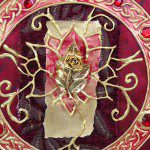
Last night I found myself comforting a student of Cards and Magic who has been worried about election day: If Trump wins…
‘Relax,’ I said, and then continued: ‘Things are as they are. Acknowledging this is a fearless act. Being fearless takes courage and requires discernment.’
I often talk about fearlessness in my cartomantic lessons, for the simple reason that this is why we read cards, namely, to get fearless. But there’s a catch to fearlessness that most people don’t think about.
Fearlessness is not for everybody. You must hide your fearlessness if you want to escape subjecting yourself to the constitutive gaze of others: ‘There goes the mad one’, people tend to say, when they look at you and all they see is your freedom: Freedom from fear.
Says culture: “What do you mean you’re fearless? You can’t be serious. We’re here to make you fearful, because that’s the only way in which we can sell you shit, from ideology to irritable colon remedies that our pharmaceutical industry has devised just for you, because you’re so special and because you deserve it.” Right.
What I’m saying is this:
Hiding that you are fearless is not only a means of protection, but it is necessary.
Hiding your fearlessness is the only way to counter the claims against madness. What did you think that all that talk about being silent is all about? Some sort of a mystical act that no one really understands, unless you are the sphinx or some ugly witch from Romania? No.
The advice about being silent, after you have done your share of willing, daring, and knowing, is related to being silent about your fearlessness.
You flaunt your fearlessness, you pay the price of subjecting yourself to pointy fingers: ‘Look at that fool,’ culture would say, and perhaps, for once, culture would be right about it.
In this sense, hiding your fearlessness is a subtle act that displays discernment and the capacity to remain dispassionate in the face of escalating threats.
What am I afraid of?
So here’s a short practice that takes its point of departure in the question I hope everyone poses to themselves as a matter of common sense practice: “What am I afraid of?”
Go through these simple steps, beginning with this very question:
- What am I afraid of?
- Make a list of your immediate concerns, for example: “I’m afraid that Trump will win today”, or “I’m afraid that my coffee doesn’t prompt me the way it used to with the regular existential question I pose about the meaning of life every morning”, or “I’m afraid that my children are not very bright”, or “I’m afraid that my husband is an asshole”, or “I’m afraid that my wife is vulgar”, or “I’m afraid that I’m lazy and incompetent”.
- Once you have identified your fear – keep to one at a time – lay down three cards and ask: “What is the purpose of my fear of . . . Trump, uninspiring coffee, children, husband, wife, myself?”
- Read your cards and devise a magical spell for yourself inspired by the cards that aims at dissolving your fear.
Here’s a recent example:
What is the purpose of my fear of my desire to be my own boss?
But first, bear in mind that you may already have an answer to the why: ‘Why am I afraid of being my own boss?,’ as this is not the most interesting.
What you want is to go beyond the why to identifying the purpose of your fear. For example, your fear of desiring to be your own boss may well be buried in your unconscious identification of ‘boss’ with ‘a lot of responsibility’ that you would prefer not to have for whatever reason. What you want is to identify the purpose of your fear. That’s a hell of a lot more sophisticated, as I hope you will discover if you try to answer this question.
The Sun, Justice, Temperance

A purpose operates with referential points, points of identification between motivation and end result. In other words, when there’s a purpose, there’s movement and direction. The dictionary defines purpose as “the reason for which something exits”. It’s good practice to transliterate your question so you really get a sense of what is at stake when you ask it, here thus: “What is the reason for which my fear exists?” that is, my fear of my desire to be my own boss.
In light of this definition of purpose, I’d read the cards like this:
The reason why this fear exists is because there’s the assumption of warm sharing in a community where no one is the boss (the Sun). If you have to rise to that function, you have to be discerning and impartial (Justice) and smooth things out if needed, making compromises (Temperance) you would rather not.
Fair enough. This is a very good reason why anyone with the desire to be their own boss may fear fulfilling that role. But is this reason, or to get back to our formulation, purpose, not based on projection?
While this situation, going from carefree sharing to policing others, may arise at any time, upon further reflection we discover that it does not validate the fear itself.
Upon even further reflection, we discover that fear has no anchor. Things flow as they flow. While flow may be regulated (Temperance) and regimented (Justice), it is still flow, pulsating from heart to heart (Sun).
So we’re back to the old noble truth: Just as nothing has substance, fear has no substance. But in a play with fear using the visual language of the cards, you may discover just how your fear dissolves and through which concrete channels of manifestation.
Once you know this, you can then hide the particulars of your fearlessness, and thus enjoy your madness beyond the vigilant and watchful eyes of your culture, passing judgment on what it deems appropriate and not.
Eat your fear
In your madness you can try this:
- Take a slice of bread and toast it (Sun).
- Cut it into two halves and weigh each of them in your hands (Justice). Get a clear sense of this balancing act. What does it need for perfection? How about some some milk and honey?
- Make a concoction of the mix and pour it over each of your two slices (Temperance).
- When you’re done, take the first slice and eat it, saying these words: This is my fear. I offer it to my body to digest and dissolve.
- Eat the second slice of toast, saying these words: This is the purpose of my fear. I offer it to my body to digest and dissolve.
- Go out in the sun and say ‘thank you’ for the illumination.
♠
More of this work?
Stay in the loop for new cartomantic activities.

Patheos Pagan on Facebook.

the Agora on Facebook
The Cartomancer is published twice monthly on the Wednesdays here on the Agora. Subscribe via RSS or e-mail!
Please use the links to the right to keep on top of activities here on the Agora as well as across the entire Patheos Pagan channel.

















